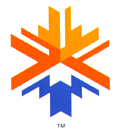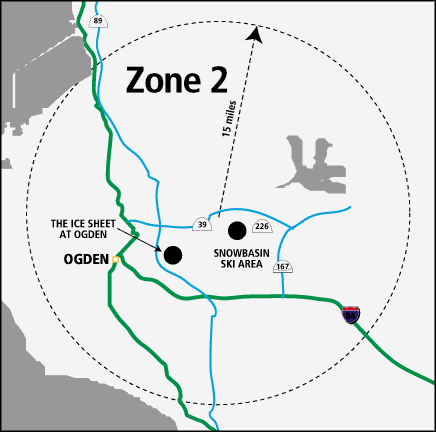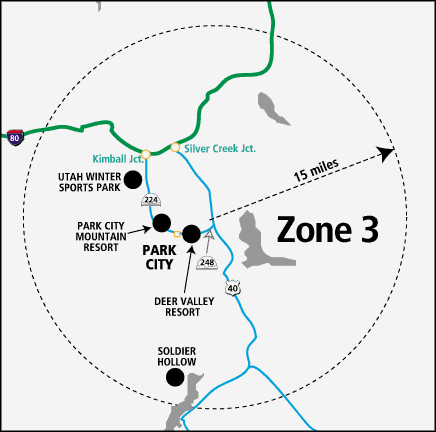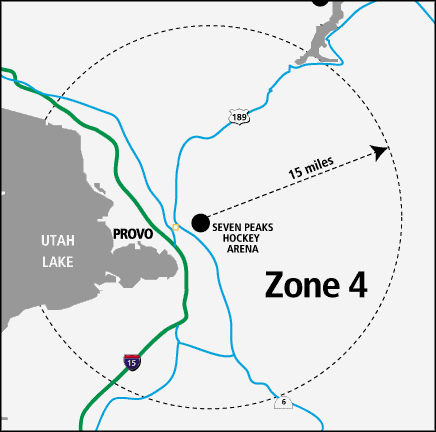 The 2002 Winter Olympic Games will begin on February 8, 2002, when more
than two weeks of athletic events will take place in and around Salt
Lake City, Utah. An estimated one and a half million spectators are
expected to attend the Games. As you might imagine, radio will play
a big part in the rapid, smooth and safe functioning of each event.
This month I'll try to describe the major trunked radio networks that
will be operating during the Olympics.
The 2002 Winter Olympic Games will begin on February 8, 2002, when more
than two weeks of athletic events will take place in and around Salt
Lake City, Utah. An estimated one and a half million spectators are
expected to attend the Games. As you might imagine, radio will play
a big part in the rapid, smooth and safe functioning of each event.
This month I'll try to describe the major trunked radio networks that
will be operating during the Olympics.
As they have done many times in the past for such large events, the Federal Communications Commission has delegated the task of radio frequency management and coordination for the Games. The Salt Lake Organizing Committee (SLOC) will be the coordinator from December 1, 2001 through March 31, 2002, for the areas in and around Olympic activities. All broadcasters planning to work in one or more of the four radio zones (Salt Lake City, Park City, Ogden and Provo) are required to coordinate their use of radio frequencies through SLOC in order to operate any wireless audio and video, data communication, two-way or other radio equipment.




Olympic Safety
Besides broadcasters, public safety personnel will be very busy as well.
The federal government has allocated about $200 million for security at the Olympic Winter Games, with the potential for more after the events of September 11. In addition, the State of Utah has contributed $35 million and the SLOC budget has more than $30 million earmarked for safety.
The Secret Service is the lead agency for security planning. The FBI is tasked with intelligence gathering and law enforcement response, while the Federal Emergency Management Agency (FEMA) is responsible for "consequence management," meaning they clean up if anything goes wrong. At the state level, the Utah Olympic Public Safety Command (UOPSC) is responsible for coordinating the activities of state and local law enforcement.
All told, there will be on the order of 5,000 to 7,000 law enforcement officers at the Games, along with several thousand additional security personnel hired through SLOC. Military personnel will also be on hand to provide assistance, so there should be a great deal of public safety radio activity.
SLOC, in concert with the State of Utah and the Utah Communications Agency Network (UCAN) has established a plan for their radio system. More than 7,000 two-way radios are expected to be in use, operating in either the 150 MHz or 800 MHz bands for both short range (within an event venue) and more distant communication.
Utah Communications Agency Network (UCAN)
UCAN is a quasi-governmental agency created by the Utah State Legislature in 1997 to construct and operate a modern radio system on behalf of numerous state, local and private safety organizations. The idea is to transition these users away from older, incompatible systems in the 150 MHz and 450 MHz bands to a common 800 MHz trunked radio network.
Funding for the roll-out of the system comes from Federal grants, the state coffers, and monthly user fees of anywhere from $15 to $30 per radio, depending on whether the user is a state agency or not. In addition, last year Congress approved $5 million for UCAN to upgrade security and communications equipment for use by law enforcement during the Olympics. Interestingly, the funding bill also included money to build and operate field-transportable radio direction finding equipment.
Phase I of the UCAN master plan provides for coverage in Davis, Morgan, Salt Lake, Summit, Tooele, Utah, Wasatch, and Weber counties, which amounts to about 80 percent of Utah's population.
Valley Emergency Communications Center
Southwest of Salt Lake City in West Valley City is the Valley Emergency Communications Center (VECC), which provides dispatch services for 15 fire departments and 8 law enforcement agencies. 9-1-1 calls from about 20 different municipalities across a 120-square-mile area are answered at the VECC, averaging 3,500 calls each day. VECC is also the headquarters for UCAN.
Besides voice, VECC provides data services to police, fire, and rescue units using Cellular Digital Packet Data (CDPD) technology. Laptop units in vehicles are connected to CDPD modems and are able to access public safety databases, letting officers run license checks and warrant requests without the need to talk with a dispatcher.
Future plans include "voiceless dispatch" in which assignments are done over the CDPD connection rather than by voice. This would free up officers and dispatchers from having to handle routine messages and allow more information about the assignment to be delivered to the officer in less time. Information such as mug shots, fingerprints, and photographs could be delivered at the time of dispatch, allowing the officer to be better prepared for the assignment.
Rather than requiring new base station equipment, the CDPD service uses the existing cellular telephone network. A vehicle can be equipped with a laptop and CDPD modem for less than $1800, and monthly service charges from the cellular provider are about $50.
UCAN SmartZone
The UCAN network is a Motorola Type II SmartZone system with a number of sites. Sites are grouped together into cells, with transmissions being simulcast from each site in a cell. This is a rather large and complex system, with a lot of frequencies. What follows is a compilation of the first eleven cells, which handle the majority of calls.
Weber County (cell 1): 866.950, 867.275, 867.300, 867.5875, 867.6125, 867.900, 867.925, 868.2375, 868.2875, 868.9625 and 868.9875 MHz.
Davis County (cell 2): 866.925, 867.175, 867.200, 867.225, 867.450, 867.475, 867.8125, 867.8375 (data), 867.850, 868.150, 868.175, 868.600 and 868.850 MHz.
Salt Lake County (cell 3): 866.875, 867.150, 867.175, 867.400, 867.425, 867.6875, 867.725, 868.0875, 868.1125, 868.4125 and 868.5125 MHz.
Utah County (cell 4): 866.725, 866.975, 867.0875, 867.325, 867.375, 867.6625, 867.950, 868.0625, 868.3375 and 868.3625 MHz.
Reservoir Hill (cell 5): 866.0625, 866.3375, 866.6125, 867.1375 and 867.8625 MHz.
Promontory Point (cell 6): 866.2500, 866.5750, 866.7375, 868.3500 and 868.7000 MHz.
Mt. Ogden (cell 7): 866.1500, 866.1875, 866.4375, 866.5500, 866.7625, 866.8000 (data), 868.6250, 868.6500, 868.8750 and 868.9000 MHz.
Morgan Peak (cell 8): 866.1125, 866.3875 and 866.7125 MHz.
Francis Peak (cell 9): 866.4875, 866.2250, 868.6750 and 868.8250 MHz.
Layton (cell 10): 868.750, 868.775, 868.7875 and 868.800 MHz.
Nelson Peak (cell 11): 866.3750, 866.4000, 866.6500, 866.7000, 866.9000 and 868.5500 MHz.
Aeromedical: 17184, 17216, 17248 and 17312
Davis County Fire: 9600, 9632, 9664, 10656, 10688, 10752, 10784, 10816, 10848, 10880 and 10912
Davis County Sheriff: 9312, 9376, 9408, 9728, 11776 and 11776
Orem Police Department: 44604, 44608 and 44672
Tooele County Sheriff: 40000 and 40032
Utah County Fire: 46240
Utah County Sheriff: 46112
Utah Highway Patrol: 9440, 19712 and 19744
Utah State Fire Air: 17184 and 17216
Wastach County Sheriff: 47200, 47264
Weber County Sheriff: 6016 and 6048
Salt Lake County
UCAN is expected to fully interconnect with Salt Lake County's existing radio system, which is a 800 MHz Motorola system spread across several repeater sites.
Frequencies: 854.5875, 854.7125, 855.4625, 856.2375, 856.7125, 856.9875, 857.2375, 857.4625, 857.7125, 857.9375, 858.2375, 858.4625, 858.7125, 859.2625859.4625, 859.7125, 859.7375, 860.2625, 860.7375, 866.0750, 866.3500, 866.6000, 866.6750, 866.8500, 867.2500, 867.7750, 868.0375, 868.4375 and 868.9375 MHz.
Salt Lake City fire talkgroups include 832, 864 and 896 while County fire uses 928, 960, 972, 976 and 992. Medical rescue talkgroups are 1408 and 1440.
Salt Lake City police use talkgroups 672, 704, 720, 736, 768 and 800. County Sheriff calls appear on a number of talkgroups, including 240, 272, 304, 336, 432, and 416. SWAT and Special Operations use 608 and 640.
Salt Lake City, Utah
Salt Lake City operates a Motorola Type I system. TrunkTracker listeners should use Fleetmap E1 P3. Frequencies are 856.7625, 856.9625, 857.7625, 857.9625, 858.7625, 858.9625, 859.7625, 859.9625, 860.7625 and 860.9625 MHz.
Since UCAN, Salt Lake County and Salt Lake City all use Motorola 800 MHz trunked radio systems, there is a proposal in the works to use a SmartZone OmniLink switch to tie them all together. This would also allow Department of Justice and Department of the Treasury wireless networks to be linked in.
Salt Lake City Airport
The Salt Lake City airport runs a Motorola Type II system using frequencies of 856.4875, 856.9875, 857.4625, 857.4875, 858.4875, 859.2375, 859.4875, 860.2375 and 860.4875 MHz.
Talkgroups 1200 and 1360 are used by the Salt Lake City Fire Department, while 528, 530, and 1136 are assigned to the airport medical rescue units. Airport Police are dispatched on talkgroups 592 and 1232 while Operations uses 848 and 880.
Latter-Day Saints Church
Salt Lake City may be best known as the headquarters of the Latter-Day Saints (LDS) Church, better known as the Mormons. They operate their own Motorola trunked radio system using the frequencies 855.2625, 855.3375, 855.5625, 856.8375, 857.8375, 858.8375, 859.8375 and 860.8375 MHz.
Orem, Utah
The city of Orem in Utah County is licensed to operate a Motorola Type II system on the following frequencies: 866.2250, 866.4250, 866.4500, 866.6250, 866.8375, 866.8875, 867.0875, 867.1375, 867.2375, 867.2875, 867.4875, 867.5750, 867.7250, 867.8875, 867.9375, 868.2875, 868.4250, 868.6125, 868.6250 and 868.9000 MHz. Note that some of these frequencies overlap with UCAN assignments. Could a Utah reader confirm that the Orem system has been absorbed by UCAN?
Provo, Utah
The city of Provo, also in Utah County, has the following frequencies assigned for a Motorola Type II system: 851.8125, 852.3875, 854.8875, 855.2625, 855.3375, 855.5375, 855.5625, 855.8125, 856.3875, 856.8625, 856.9125, 857.9125, 858.2125, 858.8875, 858.9125, 859.9375, 859.8875, 859.9125, 860.8875, 860.9125, 861.1375 and 865.1875 MHz. The system may also be absorbed by UCAN.
Hill Air Force Base
Hill Air Force Base in Davis county operates their own Motorola Type II system in the 400 MHz band. The system follows the UHF standard of 25 kHz steps and has a base frequency of 406.000 MHz. Actual frequencies in use are 406.150, 406.750, 407.250, 407.525, 408.025, 408.550, 408.950, 409.150, 409.750 and 406.2500 MHz.
The base fire department has been heard on talkgroup 10720 while flightline operations is on 9760.
Tooele, Utah
Perhaps reduced in size by now, the world's largest single stockpile of chemical weapons is located 45 miles southwest of Salt Lake City in a town called Tooele (pronounced too-ELL-ah) at the Army's Desert Chemical Depot. Since 1996 Tooele's mission has been to safely incinerate the thousands of tons of U.S. chemical weapons.
The depot is reported to operate a five-channel Motorola Type II system on the following UHF frequencies: 406.350, 407.150, 407.950, 408.750 and 409.550 MHz.
Computerized Talkgroup Logging
While scanning trunked frequencies, it is often a manual chore to write down each talkgroup that appears on the scanner display. A MT reader just might have the solution for this problem.
Dan,I am a MT subscriber and I enjoy reading your Tracking the Trunks section. I have written a program for the Bearcat 245XLT and 780XLT scanners that may be of interest to your readers. I am a programmer by profession but I also write my own software as part of my radio hobby.
I originally wrote the program for my own use to collect new IDs for my web page. I decided to release it as freeware so that others may get some use from it. The software can be found at:
http://personal.lig.bellsouth.net/lig/k/d/kd5eis/IDTracker/IDTracker.htmDavid, K5DMH
Baton Rouge, LA
David's software runs under Microsoft Windows and requires a serial connection to either a Bearcat 245XLT or a 780XLT. Talkgroup IDs from Motorola or EDACS systems are displayed and optionally logged to a disk file. His web page has comprehensive explanations of the program's features and an easy-to-use download section.
That's all for this month. I welcome your electronic mail messages at dan @ signalharbor.com, and there is more information on my web site at www.signalharbor.com. Until next time, happy monitoring!